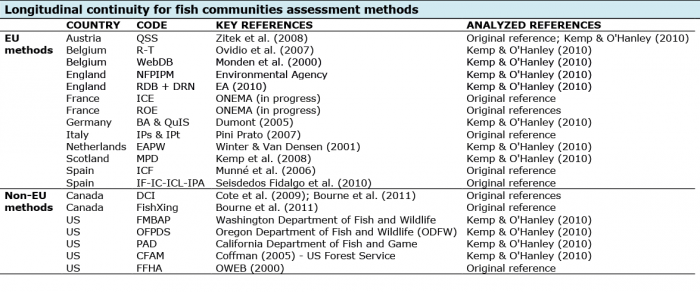Fish longitudinal continuity assessment
Fish longitudinal continuity assessment
Type
Hydromorphological assessment methods
Brief description
Methods for fish longitudinal continuity assessment aim to assess the impact that cross-sectional structures (i.e. barriers) have on the movement and migration of fish communities. While early methods simply aim to obtain a database inventory of the location of barriers, more recent methods also attempt to assess the passability of barriers (mainly at the single barrier scale) both in terms of their structural characteristics and of the biological capacities of fish communities to pass them (e.g. swimming/jumping abilities, life history). We reviewed 20 methods in total (13 for European countries and 7 for non-European countries) (Table 1).
Strengths, limitations and gaps
Methods for longitudinal continuity assessment mainly consists of an inventory of features or on an assessment of barrier passability at the single barrier scale, rather than on the effective assessment of river longitudinal continuity at the catchment scale. Despite recent progress, efforts are still needed to combine small scale assessment and large scale inventories, species biology, spatial/regional environmental diversity and river processes.
Other relevant information
Summary tables of analyzed methods for longitudinal continuity assessement are available here:
- For European countries: File:5 EU.pdf
- For non European countries: File:5 nonEU.pdf
In the table we recorded whether the analyzed method considers or not a specific feature. Three options were considered: presence (tick), absence ( ), and probably assessed (PA), the latter indicating when there is an uncertainty concerning whether the feature is collected and/or when the feature may be indirectly obtained.
Table 1 lists the key and the analyzed references for methods of longitudnal continuity assessment.
References
Bourne C., Kehler D., Wiersma Y. and Cote D. (2011): Barriers to fish passage and barriers to fish passage assessments: the impact of assessment methods and assumptions on barrier identification and quantification of watershed connectivity. Aquatic Ecology 45(3):389-403.
Coffman J.S. (2005): Evaluation of a Predictive Model for Upstream Fish Passage through Culverts. Master thesis, Harrisonburg, VA: James Madison University, 110 p.
Cote D., Kehler D.G., Bourne C., Wiersma Y.F. (2009): A new measure of longitudinal connectivity for stream networks. Landscape Ecology 24:101–113.
Dumont U. (2005): Handbuch Querbauwerke (in German). Dusseldorf: Ministerium fur Umwelt und Naturschutz, Landwirtschaft und Verbraucherschutz des Landes NRW, 214 pp.
Environmental Agency (EA) (2010): Mapping hydropower opportunities and sensitivities in England and Wales. Environment Agency Technical Report, 67 p.
Kemp P. and O'Hanley J. (2010): Procedures for evaluating and prioritising the removal of fish passage barriers: a synthesis. Fisheries Management and Ecology 17(4):297-322.
Monden S., De Charleroy D. and Van Liefferinge C. (2000): Inventory of Fish Migration Barriers on Ecological and Strategic Important Rivers in the Flemish Region (Belgium). Proceedings of the International Symposium on Freshwater Fish Conservation: Options for the future. 30 October–4 November 2000. Albufeira, 67 p.
Munné A., Solà C. and Pagés J. (2006): HIDRI: Protocolo para la valoración de la calidad hidromorfológica de los ríos. Barcelona, Agència Catalana de l’Aigua, 164 p.
ONEMA (2010): Référentiel national des Obstacles à l’Ecoulement : une cartographie nationale des obstacles sur les cours d’eau. Les fiches de l’Onema, 2 p. http://www.eaufrance.fr/observer-et-evaluer/pressions-sur-les-milieux/alterations-hydromorphologiques/?id_article=54
Ovidio M., Capra H. and Philippart J.C. (2007): Field protocol for assessing small obstacles to migration of brown trout Salmo trutta, and European grayling Thymallus thymallus: a contribution to the management of free movement in rivers. Fisheries Management and Ecology 14:41–50.
(OWEB) Oregon Watershed Enhancement Board (2000): Oregon Watershed Assessment Manual, 583 p.
Pini Prato E. (2007): Descrittori per interventi di ripristino della continuità fluviale: Indici di Priorità di Intervento. Biologia Ambientale 21(1):9-16.
Seisdedos Fidalgo P., G. Gonzalez Fernandez D. Pérez Cardenal D. Miguelez Carbajo R. Gallego Garcia R. Fernandez Suarez E. Alvarez Durango P. Canal Rubio I. Roa Alvarez and Rosa Cubo E. (2010): Diagnostico de la conectividad longitudinal de la cuenca del Duero. Clave 452-A 611.13.04/2008. Ministerio de Medio Ambiente, Rural Y Marino - Confederación Hidrográfica Del Duero - Comisaria De Aguas - Ichtios Gestión Ambiental, 25 p.
Winter H.V. and Van Densen W.L.T. (2001): Assessing the opportunities for upstream migration of non-salmonid fishes in the weir-regulated River Vecht. Fisheries Management and Ecology 8:513–532.
Zitek A., Haidvogl G., Jungwirth M., Pavlas P. & Schmutz S. (2008): An Ecologically-based Strategic Guideline for Restoring the Longitudinal Connectivity for Fish in Running Waters of Austria. 4th ECCR International Conference on River Restoration. 16–21 June 2008. Venice: European Centre for River Restoration (ECRR).
